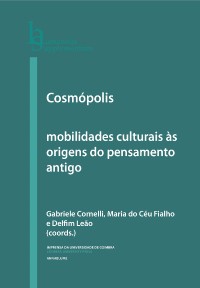Please use this identifier to cite or link to this item:
https://hdl.handle.net/10316.2/40864| Title: | Zoroastro, o Grego: Zaratustra na percepção grega e helenística | Other Titles: | Zoroaster, the Greek: Zarathustra in Greek and Hellenistic perception | Authors: | Fernandes, Edrisi | Keywords: | Cosmopolis;Greek philosophy;Zarathustra;Zoroaster;Zoroastrianism;Cosmópolis;filosofia grega;Zaratustra;Zoroastro;Zoroastrismo | Issue Date: | 2016 | Publisher: | Imprensa da Universidade de Coimbra Annablume |
Journal: | http://hdl.handle.net/10316.2/40836 | Abstract: | From the study of classical sources and reflections from modern scholars,
we have investigated the assimilation of the figure of Zoroaster (Zarathushtra), the
Iranian sage, legislator, and religious leader, in classical Greece and the Hellenistic
world, and here we present our understanding of the circumstances, mechanisms
and consequences of this assimilation. In this process, we highlight the contrast
between the “fascination with the other” and reservations toward the stranger, and
we scrutinize the transformative appropriation of Iranian thought in Greek thought,
particularly in the nascent philosophy. James R. Russell – professor of Iranian and
Armenian studies at Harvard, and one of the scholars studying the Derveni Papyrus
– teasingly said in 1989 that “Greece was closer to Persia, and had more in common
with it, than it did with the northern Europeans who invented a discipline called
Classics”. The publication by Phillip Sidney Horky of the fascinating work “Persian
Cosmos and Greek Philosophy: Plato’s Associates and the Zoroastrian Magoi” in
2009 gives a good idea of how much progress has been made in twenty years of studies
on cultural exchanges between Persia and Greece in classical antiquity. It is time
for a recapitulation on how much our knowledge about Zarathustra/Zoroaster has advanced, centering our focus on the rich heritage of the Iranian sage at the dawn of
the history of Western thought. A partir do estudo das fontes clássicas e de reflexões de eruditos modernos, investigamos como se deu a assimilação da figura do sábio, legislador e religioso iraniano Zaratustra (Zarathushtra) na Grécia clássica e no mundo helenístico, e apresentamos nosso entendimento das circunstâncias, mecanismos e consequências dessa assimilação. Nesse processo, destacamos o contraste entre o “fascínio pelo outro” e as reservas ante o estranho, e esmiuçamos a apropriação transformadora do pensamento iraniano no pensamento grego e, particularmente, na nascente filosofia. James R. Russell – professor de estudos iranianos e armênios em Harvard, e um dos estudiosos do papiro de Derveni – afirmou provocativamente em 1989 que “a Grécia estava mais próxima da Pérsia, e tinha mais em comum com ela do que com os norte-europeus que inventaram uma disciplina clamada [Estudos] Clássicos”. A publicação por Phillip Sidney Horky do fascinante trabalho “Persian Cosmos and Greek Philosophy: Plato’s Associates and the Zoroastrian Magoi”, em 2009, dá uma boa ideia do quanto se avançou em vinte anos de estudos sobre as trocas culturais entre a Pérsia e a Grécia na antiguidade clássica. É o caso de recapitularmos agora o quanto se progrediu no conhecimento que temos sobre Zaratustra/Zoroastro, centrando nosso foco na rica herança do sábio iraniano nos alvores da história do pensamento ocidental. |
URI: | https://hdl.handle.net/10316.2/40864 | ISBN: | 978-989-26-1287-4 978-989-26-1288-1 (PDF) |
DOI: | 10.14195/978-989-26-1288-1_7 | Rights: | open access |
| Appears in Collections: | Cosmópolis: mobilidades culturais às origens do pensamento antigo |
Files in This Item:
| File | Description | Size | Format | |
|---|---|---|---|---|
| zoroastro_o_grego.pdf | 333.39 kB | Adobe PDF |  |
Items in DSpace are protected by copyright, with all rights reserved, unless otherwise indicated.
